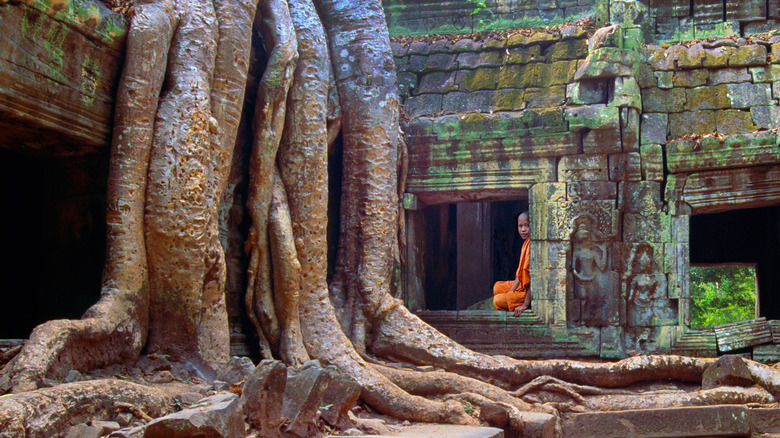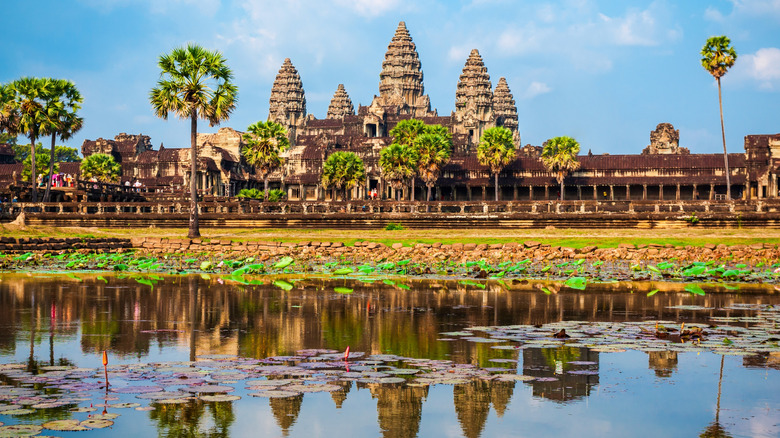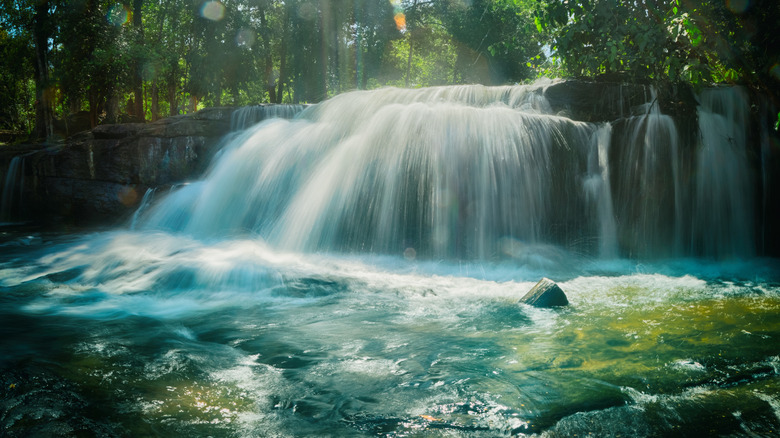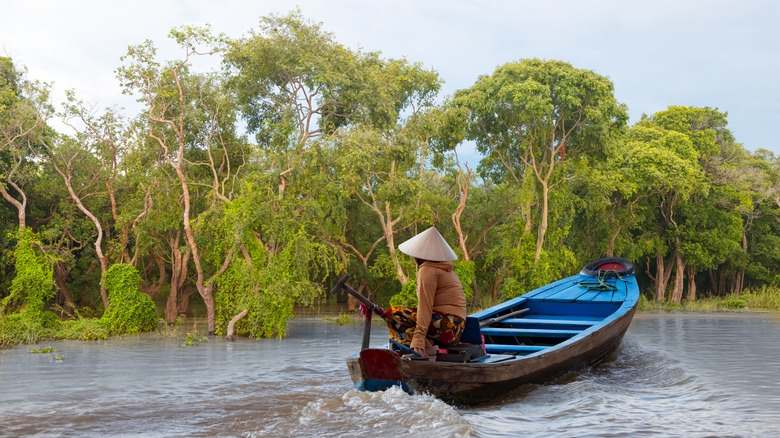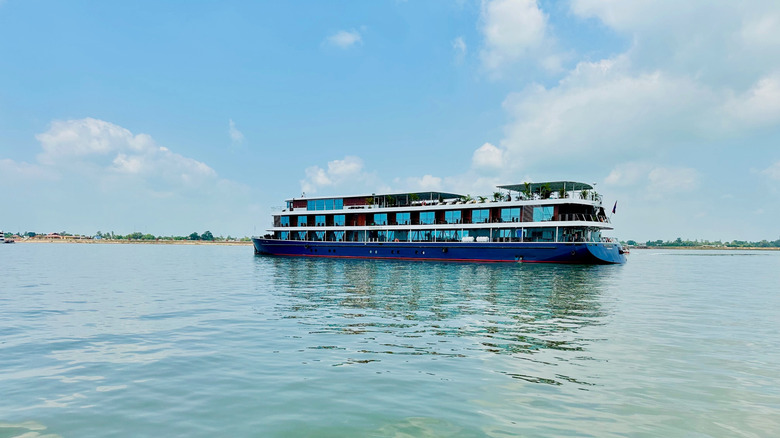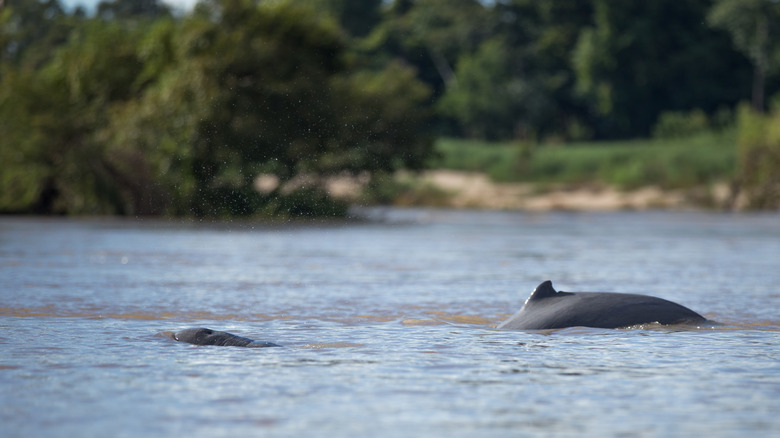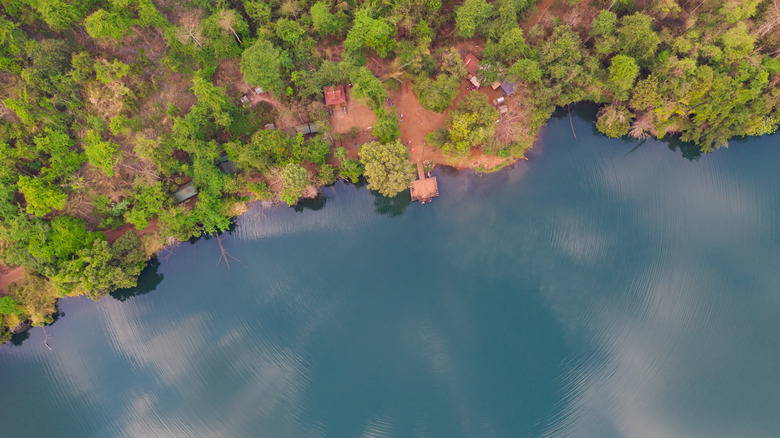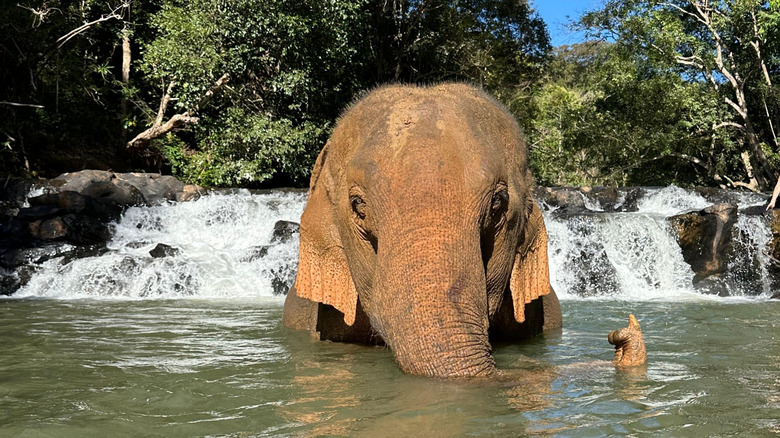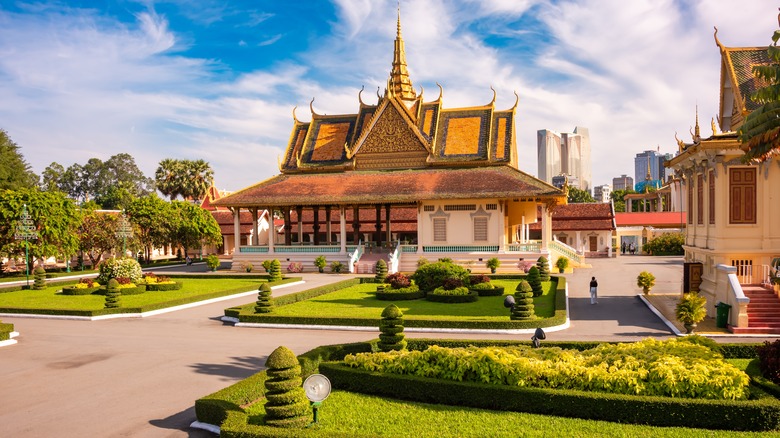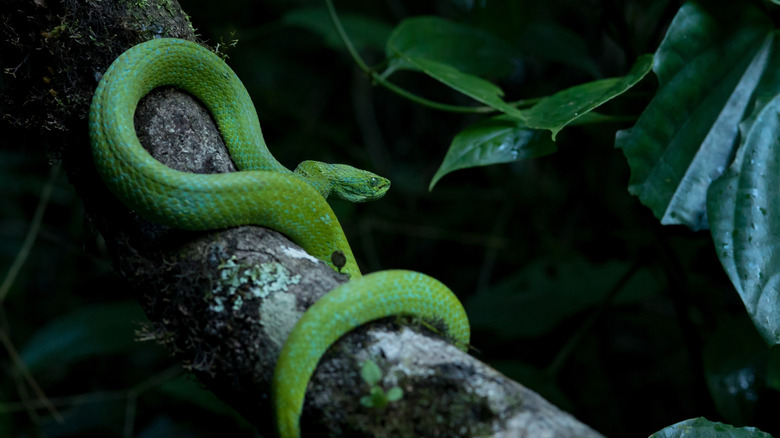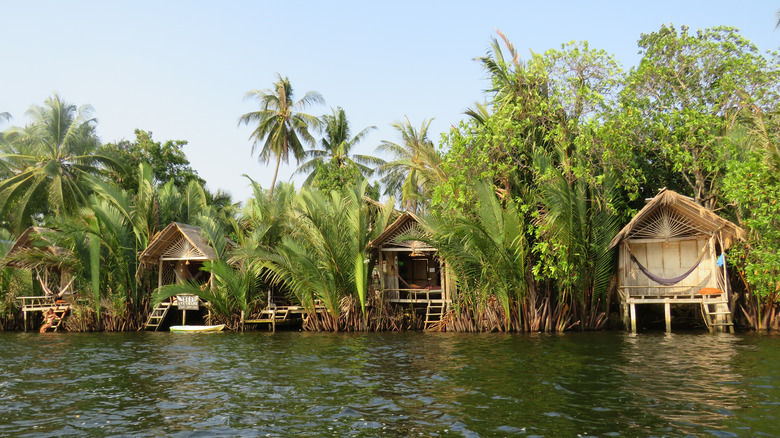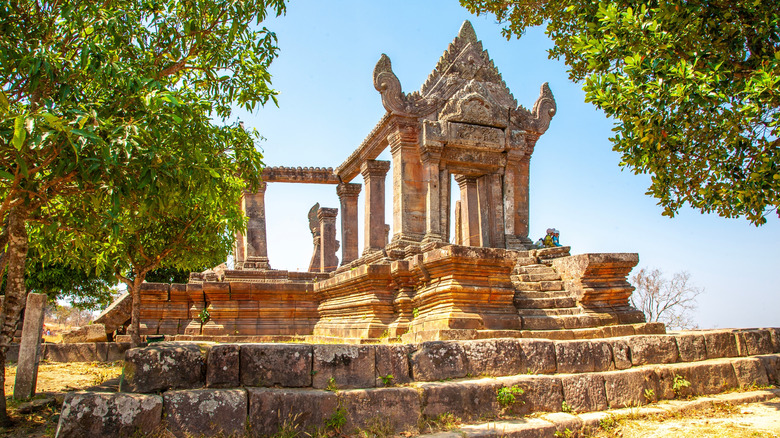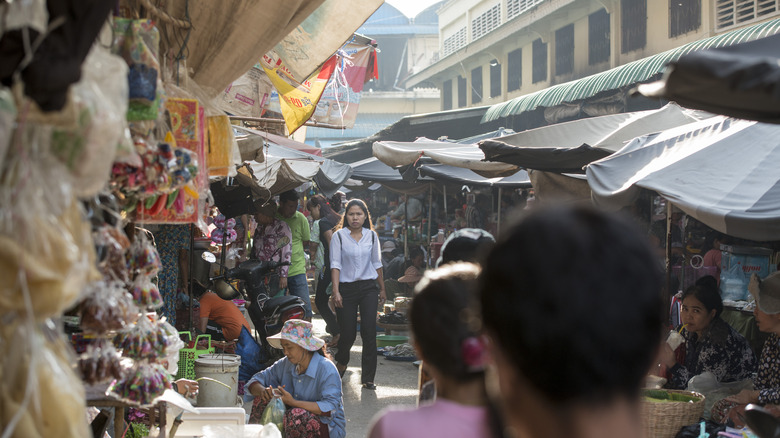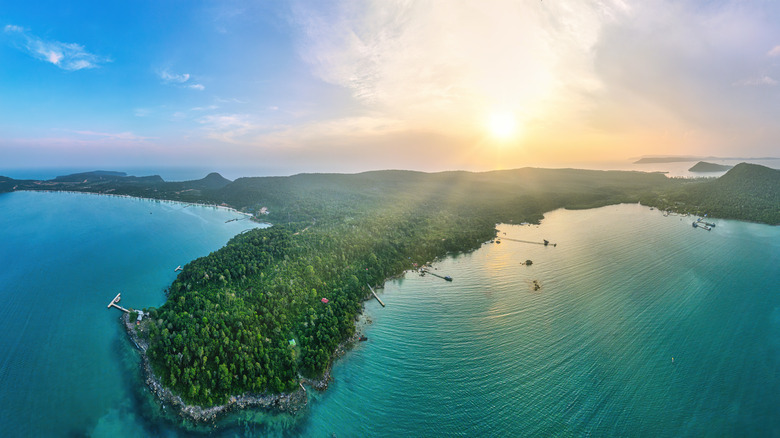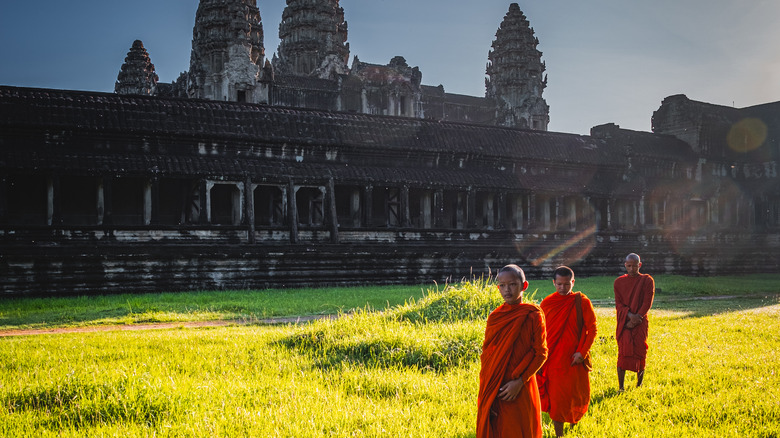Cambodia's 13 Best Tourist Attractions To Explore On Your First Trip
With the exception of Angkor Wat, which is irresistible, not everyone falls in love with Cambodia at first sight. However, give it a chance and you'll likely come to adore this gorgeous, complex, diverse country — a true gem of Southeast Asia.
Home to destinations like Angkor Wat — the world's largest religious structure — there's a reason Cambodia is called the "Kingdom of Wonder." But the country has plenty of other things going for it, including some of Southeast Asia's last true wilderness, palm-fringed beaches, intriguing cities, and a picturesque stretch of the Mekong River. On this list, you'll find the requisite temples you can't miss, along with floating villages, river dolphins, colonial cities, tropical islands, and some of the last places to see wild elephants roaming freely in Cambodia.
To land on our top picks, we used a combination of personal experience, reviews, and local tourism websites. Beyond that, we also consulted travel blogs and travel websites, as well as official sources like UNESCO, for up-to-date information about the destinations.
Angkor Wat (Siem Reap)
Cambodians display Angkor Wat on their flag — and who can blame them? The world's largest religious building, half well-preserved and half-submerged in the jungle, has lasted through centuries of Cambodian history. One of the world's most iconic tourist attractions, you could easily spend days wandering the ruins and never see all of Angkor Wat, but three days will give you a good start.
The UNESCO-listed Angkor Archaeological Park is more like a city of temples, with an estimated 1,000 buildings on-site. It was originally built in the 12th century near the city of Angkor, the capital of the Khmer Empire, and one of the largest cities in the world at the time. When Angkor was abandoned in the 15th century, local monks and villagers took over the upkeep of Angkor Wat, and it remains a sacred symbol of Cambodia to this day.
The gateway to Angkor Wat is the fast-growing city of Siem Reap, where you'll likely base yourself. Most visitors hire a tuk-tuk driver or rent a bicycle for ease of access. Pro tip: The distinctive beehive towers of Angkor Wat are best viewed at sunrise and in the early morning, and the moment when the sun first strikes the stones is heart-stirring. Once inside the complex, you can also visit Ta Prohm — often called the "Tomb Raider Temple" — and marvel at the giant faces at Bayon Temple.
Phnom Kulen National Park (Siem Reap)
Another day trip from Siem Reap, Phnom Kulen National Park is home to incredible waterfalls and a few remote temples surrounded by a lush green forest. Roughly 30 miles northeast of Siem Reap, Phnom Kulen is home to Mount Kulen — one of the most sacred peaks in Cambodia — where, according to historical records, the first king of the Khmer Empire, Jayavarman II, declared Cambodia's independence. Today, the sacred mountain is accessible via a moderate trail, and visitors can check out a pagoda, the largest reclining Buddha statue in the country, and the "Valley of a Thousand Lingas," where intricate carved figures decorate the riverbed.
Along the trail, you'll also find the gorgeous Phnom Kulen Waterfalls. Split into two sections ranging between 16 to 50 feet tall and 50 to 80 feet wide, they are ideal for a swim either before or after your hike. At the top of Mount Kulen, you'll have the opportunity to visit the Elephant Pond (Srah Damrei), which features large, moss-covered sculptures of elephants, lions, and other animals.
Tonlé Sap Lake (Siem Reap)
Siem Reap makes the list of cities you need to see in your lifetime primarily as its the gateway to the world-famous Angkor Wat ruins. However, another key site near Siem Reap is Tonlé Sap — Southeast Asia's largest freshwater lake and a major lifeblood of Cambodia. A UNESCO Biosphere Reserve, Tonlé Sap provides an astonishing amount of water and sustenance for the country, and it's estimated that roughly 50% of the population relies on Tonlé Sap for survival.
The lake is linked to the mighty Mekong River by way of the Tonlé Sap River and grows significantly during the flood season, which takes place between May and October. As the Mekong's waters spill over, the flow is reversed back into the lake, ultimately increasing the overall size from about 1,050 square miles to approximately 4,000 square miles.
The best way to explore Tonlé Sap is by boat or kayak, especially during the rainy season. Adding to the experience, the villages on the lake are either built on stilts or float year-round on bamboo platforms, offering a fascinating peek into a traditional way of life that's continued in much the same way for centuries. If you're planning on touring the floating villages, ensure the tour you book is locally-run and ethical.
Mekong River Cruise
The Mekong River, one of the longest rivers in the world, is the main artery of Cambodia and Southeast Asia. Millions of Cambodians rely upon it for water, food, transportation, their livelihoods, and even traditions, like ancient fishing practices and annual festivals. In addition, the Mekong is considered one of the world's best rivers for cruises, so it's an ideal way to appreciate it fully.
Many travelers use the Mekong to travel between Laos, Cambodia, and Vietnam, or a combination thereof. Depending on the journey, cruises can last several hours or multiple days. For a truly remote experience, consider the five-day trip between Stung Tren and Phnom Penh. You'll pass age-old villages, spot unique local wildlife, and visit several islands, including the beach-filled Koh Trong near Kratie.
You can cruise the Mekong year-round, although November through February usually has the best weather. Meanwhile, the wet season, from May to October, generally offers the best prices. And while things can definitely get rainy, the lush scenery along the river makes up for it. The hottest months of the year, April and May, are not recommended, as this is also when the river is at its lowest.
Kratie
The easygoing riverside town of Kratie is known for some of the country's best sunsets, a bustling backpacker culture, and as home to the rare, endangered Irawaddy river dolphins. Still evident today, a strong French influence is still noticeable in many of Kratie's colonial-era buildings.
Beyond its history, Kratie's location makes it a good stop between Phnom Penh and Laos, with many visitors stopping by for a night to try and see one of the famous Mekong river dolphins. Gentle creatures that resemble a gray beluga whale, Irawaddy dolphins are unique freshwater dolphins native to Southeast Asia.
Unfortunately, experts estimate that fewer than 80 Irawaddy dolphins are left in this section of the Mekong, so seeing one is a real treat. While you may be able to see a dolphin right from town, you can also take a dolphin spotting boat trip, most of which leave from the small village of Kampi, just north of Kratie. Also north of Kratie is the Mekong Discovery Trail, a network of ecotourism sites designed to introduce visitors to the local community via rural homestays, kayaking, camping, farm visits, nature treks, and countryside bike trips.
Ratanakiri Province
Far from Cambodia's most iconic sites is the Ratanakiri Province. Located in the northeast, near the borders of Laos and Vietnam, the region is known for its largely unexplored wilderness and authentic villages. Although Ratanakiri may be out of the way — it's approximately 8 hours via bus from Phnom Penh — the trip is worth it. The main village of Ratanakiri is Banlung, known as the "Red City" thanks to the ever-present red dust, and it's also the best place to base yourself when in Ratanakiri. Pro tip: the notorious red dust of Ratanakiri means you'll want to avoid wearing white at all costs.
Just 10 minutes from town via car, tuk-tuk, or motorbike is Yeak Loam — a gorgeous volcanic crater lake in the middle of the rainforest. Stop in the clear turquoise water for a swim, visit the nearby museum dedicated to the Tampuan Khmer Loeu tribe where you can also purchase Indigenous handicrafts, or hike to the nearby Kachang Waterfall, ideal for swimming and exploring.
To visit Cambodia's largest national park, Virachay, it's best to take a guided, multi-day trek. From Banlung it can take up to five hours to reach depending on the weather, even though it's only approximately 30 miles away. Additionally, a guide can also arrange a bamboo rafting experience through the park.
Mondulkiri Province
Also in Cambodia's northeast frontier, or the "Wild East," is Ratanakiri's neighbor, Mondulkiri Province. Mondulkiri translates to "Meeting of the Hills," and the higher altitude makes the region much cooler than the rest of the country. Base yourself in Sen Monorom, the province's main city — located about six hours from Phnom Penh — to explore this untouched place, a favorite of coffee and avocado lovers.
Like Ratanakiri, roughly 80% of Mondulkiri's population is comprised of indigenous groups — primarily of the Phnong (or Bunong) tribe. Today, many of its members lead jungle treks through the massive rainforest, which include traditional food, visits to local villages, Indigenous plant lore, camping in hammocks, and wild swimming in the two-tiered Bousra Waterfalls.
Additionally, the Mondulkiri Project — which is "100% Cambodian-owned and operated" — offers one-, two-, or three-day tours to visit their elephant sanctuary. These experiences directly support "forest conservation, elephant rescue, and local communities — providing jobs, medicine, and food to Bunong hill tribe families" (via Mondulkiri Project). In addition to visiting the elephants, travelers can also zip-line through the jungle or spot other wildlife like gibbons, bats, or leopards.
Phnom Penh
Phnom Penh — Cambodia's lively and modern, yet still ancient, capital — is an affordable, tourist-friendly haven full of art, temples, and upscale dining. Here, you can learn more about the history of Cambodia, covering everything from the kingdom of Angkor to the bloody rule of the Khmer Rouge.
Once called the "Pearl of Asia," Phnom Penh retains much of its former grandeur in places like the ornate Royal Palace, the sparkling Silver Pagoda (which also features a diamond-encrusted Buddha), the Art Deco Central Market building, and the hilltop gardens surrounding Wat Phnom. You can even see original sculptures taken from Angkor Wat at the impressive National Museum, which features a gorgeous courtyard garden.
Away from the chaos, towering skyscrapers, and temples, the Tuol Sleng Genocide Museum and the Choeung Ek Killing Fields are two must-visit sites. Here, you'll learn about the horrors of the Khmer Rouge under the Pol Pot regime. Tuol Sleng was a high school-turned-torture center, where prisoners were brutally interrogated before their murder in the infamous Killing Fields. Pay your respects at the shrine — which displays many bones and clothes from the victims — and perhaps meet one of the survivors, some of whom share their experiences on-site.
Koh Kong Conservation Corridor and the Cardamom Mountains
The vast Koh Kong Conservation Corridor covers a section of the Cardamom Mountains, one of Southeast Asia's last great jungles. This green corridor is best explored by motorcycle, staying at one of the incredible floating bungalows of an ecolodge, or on a boat through the unique mangrove forests. From Cambodia's tallest mountain to the flooded mangroves, and the lush Tatai River, Koh Kong is a true off-the-grid destination ideal for adventure enthusiasts and home to a plethora of natural jewels.
If you opt not to stay in one of the ecolodges, the town of Koh Kong — within the province of the same name — is an ideal base for exploring the region. It's also the easiest town to reach from other destinations: simply take a ferry from Bangkok (seven hours) or a bus from Phnom Penh (4 to 5 hours).
Within the conservation corridor you'll find the Peam Krasaop Wildlife Sanctuary, home to one of the last remaining mangrove forests in Southeast Asia. While the sanctuary has several pathways leading through the forest, along with an observation tower, the best way to really experience them is via boat tour. Other highlights of Koh Kong include river beaches, jungle trails, multiple waterfalls — such as the impressive Tatai Falls — and several unique Buddhist temples.
Kampot and Kep
The twin cities (and provinces) of Kep and Kampot in southern Cambodia are close enough to visit in one day, and are considered some of the best places to visit in Southeast Asia. Riverside Kampot is known for its French colonial architecture, river resorts, and nearby salt and pepper plantations. Additionally, visitors can take a break from the heat in the cooler climate of Bokor National Park — where a winding mountain road makes the ride up especially scenic — and even spend the night at the top in a new resort.
Also on top of the mountain is the abandoned French resort town of Bokor Hill Station, where many old buildings — including a church — can be explored. Within the misty mountain paradise, guests can also swim at the Popokvil Waterfall and might even spot endangered animals, like the Asiatic black bear. At the entrance to the national park, make sure to check out the Black Palace, or Damnak Sla Khmao — a former royal residence for King Sihanouk dating to the 1930s.
Beachy Kep is just 30 minutes from Kampot. Like Kampot, Kep is within easy reach of its namesake national park, has its own selection of ruins and cave pagodas, and is also home to a famous crab market. With the pepper farms nearby and the prevalence of crab, Kep's regional speciality isn't so surprising: crabs fried in pepper. The abundance of seafood also means there are several lovely beaches and nearby islands, including Rabbit Island (Koh Thonsáy), along the coast. Finally, both Kampot and Kep are ideal bases to explore the region's iconic salt flats or pepper farms. Rent a bike in town and head out to explore the countryside at your leisure.
Preah Vihear Temple (Dângrêk Mountains)
The queen of Cambodia's mountain temples, Prasat Preah Vihear, is a remote outpost along the border with Thailand. A Hindu temple dedicated to Shiva, it was constructed approximately 300 years ago and is hard to reach. And while you might be dealing with temple fatigue after Angkor Wat, this one feels entirely different.
High in the Dângrêk Mountains, the large, multi-story temple — technically a series of temples — is built along the edge of a cliff overlooking the plains. Unlike the temples of Angkor, half of the allure of Preah Vihear is its breathtaking mountain setting, making it one of the most unique built during the Khmer Empire.
As the temple sits along a once-contested section of the Thailand-Cambodian border, you may find yourself crossing the border when exploring the site — so bring your passport! To reach Preah Vihear, you'll have to travel from either Siem Reap (four hours) or Phnom Penh (seven hours).
Battambang
Well-preserved Battambang is a traditional colonial city on the banks of the Sangkae River. Here, you can wander streets lined with French facades, visit one of the many relaxed riverside cafes and boutiques, and browse the goods in the central market. Alternatively, you can also take a cooking lesson at Cambodia's oldest cookery course, where you'll learn to make fish amok — Cambodia's national dish.
Battambang's steets are charming enough for anyone, but several of the city's best sights are outside of the center. One of the most iconic experiences is the bamboo train, where a platform built out of bamboo is attached to four wheels and an engine. Originally built to transport goods and villagers through the rural countryside — and to compensate for Cambodia's general lack of trains — they're now most often used by tourists.
Additionally, the nearby Phnom Sampeou mountain is home to multiple caves known for two very different things: as one of the Khmer Rouge's most notorious execution spots, and for the nightly ritual of tens of thousands of bats streaming into the sky at sunset. Battambang is also in the center of the "Rice Bowl of Cambodia," where most of the rice for the country is grown, and visitors can easily stop by the expansive fields in the afternoon on their way to Phnom Sampeou.
Koh Rong and Koh Rong Samloem
Although Cambodia's islands don't get the attention of the famous Thai islands, they're still a slice of paradise, often with way fewer crowds. Plus, these gorgeous islands won't break the bank, either! While many travelers head to Sihanoukville, on Cambodia's southern coast, in search of that iconic Southeast Asian sea and sun, the town is best used as a jumping-off point to two of Cambodia's most islands: Koh Rong and its sister island, Koh Rong Samloem. With crystal-clear water, sandy beaches, pristine coral reefs, and simple little resorts, these two islands are the paradisiacal escape of your dreams.
Kong Rong, considered one of the world's most underrated tropical escapes, is about an hour ferry ride from Sihanoukville; while the Koh Rong Samloem ferry takes about 45 minutes. Koh Rong is typically the more lively of the two — especially on Koh Tuch Beach, brimming with hostels, bars, and nightclubs. In contrast, the main tourist beach on Koh Rong Samloem, Saracen Bay, is a peaceful and serene paradise, lined with just a few resorts. Whichever island you choose, though, you're guaranteed fun in the sun, on the sand, and in the water. And if you can't decide, it's also possible to travel between the two, as they're located about 15 minutes apart, also via ferry.
Methodology
To land on our final 13 picks for the top destinations you can't miss in Cambodia, we sourced information regarding cultural significance and historical context from official websites like UNESCO, the official Cambodia Ministry of Tourism, and local tourism boards.
Additionally, we also relied travel blogs — especially those with a focus on Cambodia or Southeast Asia — and travel websites like Reddit, Lonely Planet, and the writer's personal experiences to guide our decision and help us identify the top destinations that showcase the beauty and diversity of Cambodia.
